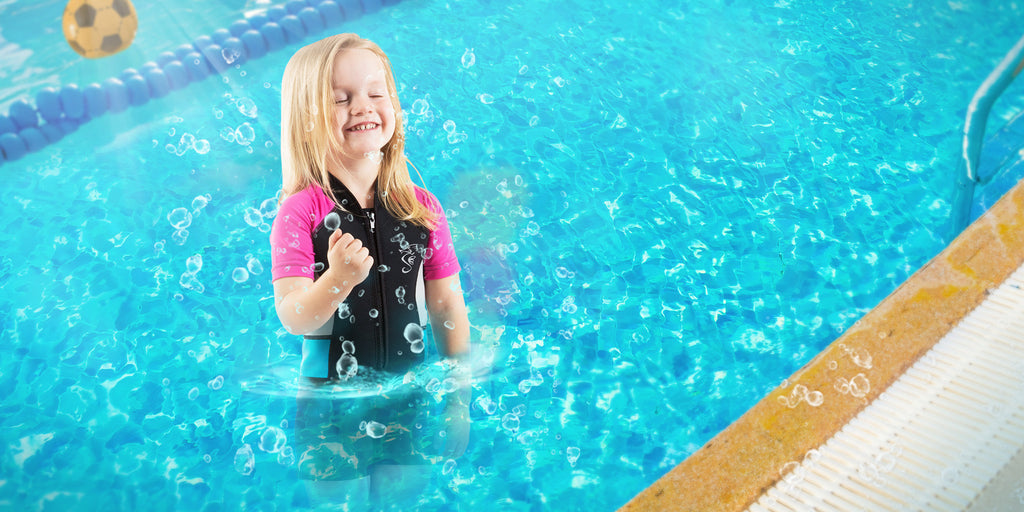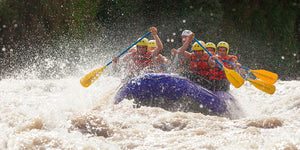Helping Kids Overcome Fear In The Water

It’s very common for toddlers and young children to have a fear of large bodies of water, such as pools, lakes or the sea, but don’t let that fear keep them from learning to swim. It’s a valuable survival skill in life, and will open up a world of water play and sports fun they can enjoy for the rest of their lives.
The first step is finding out what it is about the water your child fears. The fear may be related to factors you can minimize or even eliminate. Here are some of the most common reasons for kids to resist going into the water, and how you can address each one.
The water feels cold.
A child who’s used to the luxurious warmth of a bath may be surprised to learn that not all water feels like that. Even if you have a private pool you like to keep warm, eventually kids will encounter a different pool, a lake or the ocean, so it’s a good idea for them to learn early on how to cope with chillier water. In time, with repeated exposure, they’ll learn that the body can quickly adjust to water as cool as 20 degrees below normal body temperature, especially when swimming or playing in the water.
You can give them an extra boost of confidence in making the transition with a special “shorty” style bathing suit that has neoprene panels for added warmth. This type of suit is a step between a regular bathing suit and an actual, all-neoprene shorty style wetsuit, and offers more warmth than a regular bathing suit can. The Seavenger Kids 2mm UV Shorty offers colorful, stretchy, breathable Lycra side panels and comes in a variety of color choices.
The child is afraid of falling down into the water or drowning.
Of course swimming lessons will go a long way toward stamping out this particular fear, but you’ve got to get kids in the water first. Most community pools and private swim instructors offer ‘water readiness’ classes as a precursor to actual swim lessons, and that’s the best place to start. In these classes an adult goes into the pool with the child for various types of water play intended to give the child positive associations with water and lay the foundation for learning swimming skills.
Water readiness instructors are used to dealing with toddlers and kids who are afraid of the water, so don’t be alarmed or feel self-conscious if your child is initially resistant to the class. Keep a cool head and let the instructor guide you and your child to work past the fear.
Pools are fine, but the child is afraid of being stung by jellyfish at the beach.
Your first line of defense on this one is knowledge. Do a little online research into the shoreline or area you intend to visit. While of course it’s possible for any aquatic creature to be found outside its normal habitat, there are many beaches where jellyfish are not typically found in the shallows, or are only commonly found at certain times of year. Often, the fear of jellyfish stings will turn out to be unfounded.
If jellyfish encounters are a possibility, you can take preventive measures.
Swim pants, long-sleeved swim shirts and full-length jumpsuits made of stretchy Lycra prevent jellyfish stings in two ways. First, they provide a physical barrier against the stinging tentacles. Second, they prevent the body from giving off the chemical signals jellyfish rely on to target potential prey.
Another option is to use the recently-developed Safe Sea® jellyfish repellent lotion. It’s available with or without sunscreen, and has been proven in laboratory tests to protect against jellyfish stings without causing any damage or contamination to aquatic life.
The child is afraid of other aquatic creatures.
It’s important to remember that this is not a totally unjustified fear. There are many dangerous creatures that make their homes in oceans and lakes. However, the great majority of them are not aggressive and will do all in their power to avoid having any encounter whatsoever with humans. We are much more of a threat to them than they are to us, and most of them seem to know it. Those that are territorial or aggressive are generally found in deeper waters, well away from shorelines frequented by kids and families.
Education is the best defense here. Take your child to the aquarium or watch some nature documentaries about aquatic creatures together, so the child can learn more about the mysterious creatures of the deep to let curiosity and fascination take the place of fear.
Once they get past their initial fear, most kids quickly learn to love the water.
Credit: Photo by awesomecontent / Freepik
- Watersports Staff






Comments 0